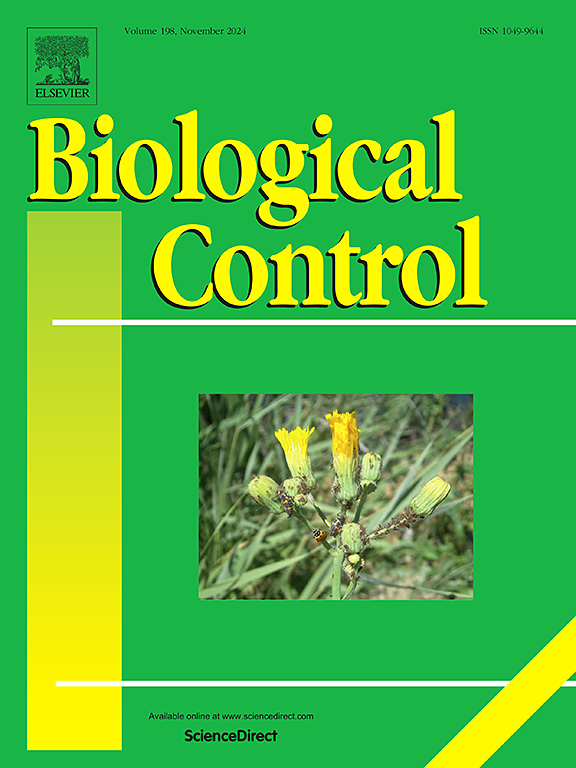Control effect of Phlebia acerina MY51 on blueberry gray mold and its impact on interfoliar microorganisms
IF 3.4
2区 农林科学
Q2 BIOTECHNOLOGY & APPLIED MICROBIOLOGY
引用次数: 0
Abstract
Blueberry gray mold is caused mainly by Botrytis cinerea. We isolated a strain of Phlebia acerina MY51 from blueberry fungi, which showed a potent inhibitory effect on B. cinerea. Our study revealed that MY51 wrapped B. cinerea hyphae, causing deformation and exhibiting strong broad-spectrum antifungal effects. The mycelium of B. cinerea was significantly inhibited by volatiles, broth metabolites and the dual culture combined with the MY51 strain, with inhibitory rates of 47.67%, 39.33% and 46.10%, respectively. Twelve known antibacterial metabolites were detected in the methanol extract of its fermentation broth. In the pot experiment, MY51 significantly enhanced disease resistance, achieving an efficacy of 73.42%, against blueberry gray mold in addition to its capacity to stimulate growth. In the control experiment, different inoculation sequence treatments resulted in remarkable control effects of 76.96% and 70.89%, respectively. Upon MY51 inoculation, the activities of CAT, SOD, POD, PPO, and PAL significantly decreased in comparison with those in the CK. With the first and subsequent MY51 injection, the enzyme activity increased by 1.66%, 136.90%, 23.87%, 38.95%, and 96.61% and 15.69%, 32.50%, 20.00%, 196.25%, and 84.29%, respectively. Significant alterations in the blueberry interfoliar microbial community were caused by MY51 inoculation. Reference databases were used, and taxonomy annotation was conducted. The main microbial phyla identified were Ascomycota, Basidiomycota, Firmicutes, Actinobacteria, Proteobacteria, and Bacteroidetes. Most of the bacteria and fungi present are considered beneficial, such as Trichoderma, Aureobasidium, Vishniacozyma, Alcaligenaceae, Bacillus, and Pseudomonas. In conclusion, MY51 can considerably reduce blueberry gray mold outbreaks and offers fresh approaches for field management.
白蜡菌MY51对蓝莓灰霉病的防治效果及其对叶间微生物的影响
蓝莓灰霉病主要由灰葡萄孢菌引起。我们从蓝莓真菌中分离到一株对灰孢杆菌有较强抑制作用的芽孢杆菌MY51。我们的研究发现,MY51包裹了灰葡萄球菌菌丝,使其变形,并表现出较强的广谱抗真菌作用。挥发物、肉汤代谢物和与MY51菌联合培养对灰绿杆菌菌丝的抑制作用显著,抑制率分别为47.67%、39.33%和46.10%。在其发酵液的甲醇提取物中检测到12种已知的抗菌代谢物。在盆栽试验中,MY51除具有促进生长的作用外,还显著增强了蓝莓灰霉病的抗病性,达到73.42%。对照试验中,不同接种顺序处理的防治效果分别为76.96%和70.89%。接种MY51后,与对照相比,CAT、SOD、POD、PPO和PAL活性显著降低。首次和后续注射MY51后,酶活性分别提高了1.66%、136.90%、23.87%、38.95%和96.61%,15.69%、32.50%、20.00%、196.25%和84.29%。接种MY51后,蓝莓叶间微生物群落发生显著变化。采用参考数据库,并进行分类标注。鉴定出的主要微生物门为子囊菌门、担子菌门、厚壁菌门、放线菌门、变形菌门和拟杆菌门。大多数存在的细菌和真菌被认为是有益的,如木霉、金黄色葡萄球菌、Vishniacozyma、Alcaligenaceae、芽孢杆菌和假单胞菌。总之,MY51可以显著减少蓝莓灰霉病的爆发,为田间管理提供了新的方法。
本文章由计算机程序翻译,如有差异,请以英文原文为准。
求助全文
约1分钟内获得全文
求助全文
来源期刊

Biological Control
生物-昆虫学
CiteScore
7.40
自引率
7.10%
发文量
220
审稿时长
63 days
期刊介绍:
Biological control is an environmentally sound and effective means of reducing or mitigating pests and pest effects through the use of natural enemies. The aim of Biological Control is to promote this science and technology through publication of original research articles and reviews of research and theory. The journal devotes a section to reports on biotechnologies dealing with the elucidation and use of genes or gene products for the enhancement of biological control agents.
The journal encompasses biological control of viral, microbial, nematode, insect, mite, weed, and vertebrate pests in agriculture, aquatic, forest, natural resource, stored product, and urban environments. Biological control of arthropod pests of human and domestic animals is also included. Ecological, molecular, and biotechnological approaches to the understanding of biological control are welcome.
 求助内容:
求助内容: 应助结果提醒方式:
应助结果提醒方式:


